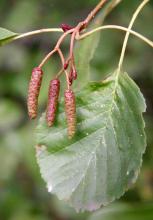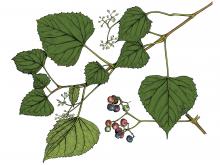Trees, Shrubs and Woody Vines
Media

Species Types
Scientific Name
Cornus amomum
Description
Swamp dogwood, or silky dogwood, grows nearly statewide in wet locations. Recognize it by its reddish-brown or dark brown young branchlets and blue, berrylike fruit, conspicuous in late fall.
Media

Species Types
Scientific Name
Cornus spp.
Description
Missouri’s five species of dogwoods are shrubs or small trees with distinctive flowers, fruits, and bark. The fruits may be red, white, or blue. The leaves have characteristic arching veins.
Media

Species Types
Scientific Name
Cornus foemina
Description
Gray dogwood is a deciduous, thicket-forming shrub. Its small, creamy-white flowers occur in branched clusters, and its white or pale blue fruits are supported by red stalks — a characteristic that makes it attractive for ornamental uses.
Media

Species Types
Scientific Name
Cornus drummondii
Description
Rough-leaved dogwood is one of Missouri's hardiest shrubs, capable of withstanding cold and drought. The leaves of this thicket-forming species emit a faint odor of sour milk.
Media

Species Types
Scientific Name
Quercus palustris
Description
Pin oak is one of the easiest trees to recognize by its shape alone: It has a tall, straight trunk, an overall pyramidal or conical shape and, most notably, the branches on the lower third of the tree angle downward.
Media

Species Types
Scientific Name
Alnus glutinosa
Description
Native to Europe and Asia, European, or black alder is planted widely as an ornamental. In some parts of the United States and elsewhere in the world, this species becomes weedy, even invasive. In Missouri, you are most likely to encounter it in landscaped areas, and not in the wild.
Media

Species Types
Scientific Name
Toxicodendron radicans
Description
Poison ivy is a toxic plant that contains an oil in all its parts that, if you come into contact with it, can cause an intense skin reaction. Learn to recognize it, and sidestep it on your outings.
Media

Species Types
Scientific Name
Physocarpus opulifolius
Description
An attractive shrub with wide-spreading, graceful, recurved branches and bark peeling off in conspicuous thin strips, ninebark is found throughout southern and eastern Missouri on gravel bars, rocky stream banks, and bluffs along streams. It's very popular as a native landscaping shrub, too.
Media

Species Types
Scientific Name
Ampelopsis cordata
Description
Raccoon grape is a woody vine climbing by tendrils to a length of 60 feet. The most aggressive native vine in the state, it can smother small- to medium-sized trees.
Media

Species Types
Scientific Name
Vitis cinerea
Description
Winter grape is a wild grapevine that can climb up to 50 feet. It occurs in low woods and along streams, in thickets, and in fencerows. It’s common in the southern two-thirds of Missouri.
See Also
About Trees, Shrubs and Woody Vines in Missouri
There are no sharp dividing lines between trees, shrubs, and woody vines, or even between woody and nonwoody plants. “Wood” is a type of tissue made of cellulose and lignin that many plants develop as they mature — whether they are “woody” or not. Trees are woody plants over 13 feet tall with a single trunk. Shrubs are less than 13 feet tall, with multiple stems. Vines require support or else sprawl over the ground.





















